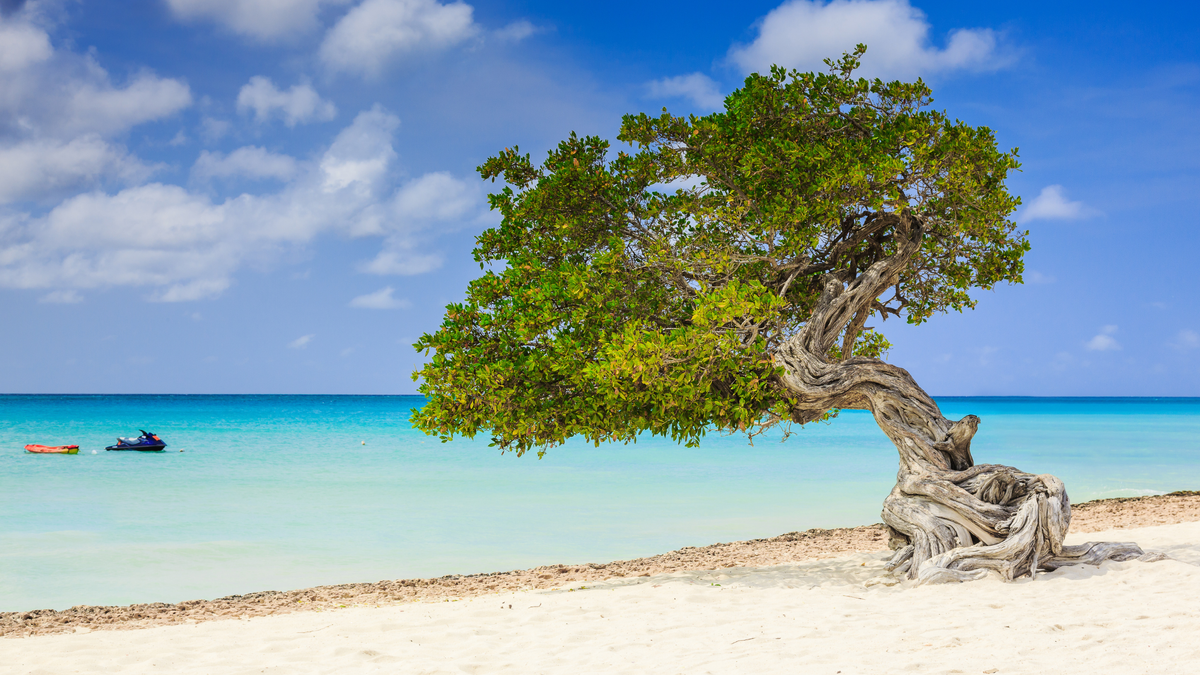St. Thomas Travel Guide For First-Time Visitors In 2025
Let's explore the islands of St. Thomas, and help you plan your upcoming adventure to the island.
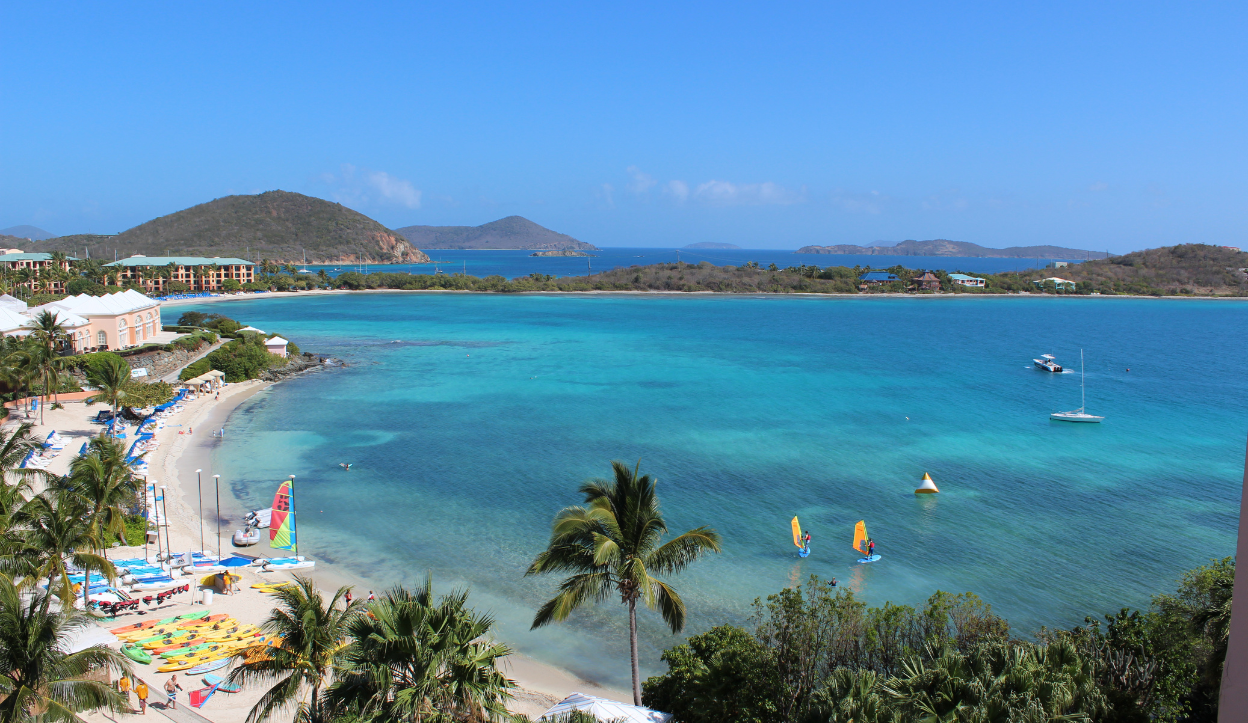
Whether you’re a fellow beach bum, an avid snorkeler or diver like me, or just someone who loves exploring new places, this St. Thomas travel guide will walk you through everything you need to know about visiting this incredible island. So, let’s dive right in! (Pun definitely intended).
Getting To Know St. Thomas
St. Thomas became part of the United States through a purchase from Denmark, a process that dates back over a century.
St. Thomas is not a large island compared to others in the Caribbean. It is part of the U.S. Virgin Islands and covers an area of about 32 square miles (83 square kilometers).
The island is around 13 miles long and 4 miles wide at its widest point. Charlotte Amalie serves as the capital, airport and a key port for cruise ships.
How St. Thomas Became a U.S. Territory
St. Thomas, along with the islands of St. John and St. Croix, was part of the Danish West Indies for centuries. The U.S. first showed interest in acquiring the islands during the Civil War as a potential naval base, but it wasn’t until 1917 that the U.S. finally purchased them from Denmark for $25 million in gold. The purchase was partly motivated by strategic concerns during World War I—the U.S. wanted to ensure that Germany wouldn’t use the islands as a submarine base in the Caribbean.
The official transfer of the islands to the United States happened on March 31, 1917, a date that is now celebrated annually as Transfer Day in the U.S. Virgin Islands. On this day, the Danish flag was lowered, and the American flag was raised, marking the transition of the islands to U.S. control.
A Glimpse into St. Thomas' History
Before European colonization, St. Thomas was inhabited by Ciboney, Arawak, and later Carib Indigenous peoples. The island’s location made it a strategic point in the Caribbean, attracting European colonizers.
Denmark established its presence on the island in the 1670s, and St. Thomas became a bustling center for sugar plantations. Enslaved Africans were brought to work on the plantations, making up a large part of the population. Charlotte Amalie, now the capital of the U.S. Virgin Islands, was a key port during this period, becoming known for its harbor and as a haven for pirates and privateers.
By the 1800s, the sugar industry had declined, and Denmark’s control of the islands became more of a financial burden. The U.S. considered purchasing the islands multiple times throughout the 19th century but never followed through—until World War I made the islands' strategic location in the Caribbean more valuable.
After the U.S. purchase, St. Thomas and the other islands were designated as an unincorporated territory. The residents of St. Thomas, St. John, and St. Croix became U.S. citizens in 1927. Today, while the islands don’t have voting representation in Congress, they have a non-voting delegate and participate in the U.S. presidential primaries.
St. Thomas’ blend of Danish colonial history, Caribbean culture, and American influence makes it a unique destination today, rich in stories and traditions. From its bustling past as a port town to its role as a tropical U.S. territory, St. Thomas has a complex history that’s worth exploring during any visit.
What I Disliked About St. Thomas
Let’s get the one thing I really didn’t like about St. Thomas out of the way—the roads and driving.
It’s the only place in the U.S. and its territories where you drive on the left side of the road. After 25 years of driving on the right, adjusting was a challenge. The weird part? I’ve driven on the left side in other countries—like the UK and Thailand—and never had an issue. But here, it’s different. In St. Thomas, everything feels American—the stores, the people, the overall vibe. It’s like suddenly having to drive on the left side in Florida. You keep forgetting because it feels like you’re still in the U.S. mainland.
Unlike driving abroad, where the foreign culture keeps you constantly aware of the difference, St. Thomas makes you feel right at home—until you hit the roads. Thankfully, it was only for a week, and once I got the hang of it, I could focus on all the amazing things this island has to offer. I’ve got a few more minor knocks below, but this was definitely the standout frustration for me.
Tourism Seasons
Peak Season
Mid-December to Mid-April
What to Expect:
- This is the most popular time to visit St. Thomas, especially for those looking to escape colder climates.
- The weather is sunny and dry, with daytime temperatures in the low to mid-80s (°F) and cooler evenings in the 70s.
- The dry season means little to no rain, making it perfect for beach days and outdoor activities.
Crowds and Prices:
- Expect more tourists, especially around Christmas, New Year’s, and Spring Break.
- Hotels, resorts, and airfare tend to be more expensive during this time.
- Popular beaches like Magens Bay and Sapphire Beach can get busy.
- Cruise ships are frequent, leading to bustling days in Charlotte Amalie.
Off-Season
Mid-April to Mid-December
(This combines both the Shoulder Season and Low Season)
What to Expect:
- Mid-April to Early June & Late November to Mid-December (Shoulder Season):
- A great balance between good weather and fewer crowds.
- The dry season is winding down, with warm temperatures and occasional showers.
- Similar conditions just before the peak tourist influx.
- June to November (Low Season):
- Corresponds with the hurricane season in the Caribbean.
- Highest risk of storms from August to October.
- The wet season brings more rain showers and humidity, usually in short bursts followed by sunshine.
- Temperatures remain in the mid-80s during the day.
Crowds and Prices:
- Shoulder Season:
- Fewer tourists compared to the peak season.
- Beaches and popular attractions are less crowded.
- Accommodation rates and airfare are generally more affordable.
- Ideal for travelers seeking a quieter experience without the high-season price tag.
- Low Season:
- The least crowded time of year in St. Thomas.
- Offers a more relaxed vibe and empty beaches.
- Hotel rates, resort stays, and airfare are at their lowest.
- Many places offer promotions and discounts.
- Some attractions or restaurants may have shorter hours or be closed for maintenance.
By categorizing the seasons into Peak Season and Off-Season, you can better plan your trip based on your preferences for weather, crowd levels, and budget. The peak season offers the best weather but at higher costs and with more tourists, while the off-season provides affordability and tranquility, albeit with a higher chance of rain and some operational limitations.
Seasonal Weather and Climate
I've had the chance to visit St. Thomas during two different seasons—one trip during the dry season in February and another during the wet season in October. Each time, the island’s weather painted a very different picture, and while both trips had their highlights, I definitely developed a preference. Here’s what it was like, and which one I’d choose to do again.
St. Thomas ranges in temps from 79 to 84 degrees all year, so you can expect 80+ degrees no matter when you visit,
My February Visit During The Dry Season
My first trip to St. Thomas was in February, right in the middle of the dry season, and honestly, it felt like paradise. The weather was just about perfect. Most days, temperatures hung in the low to mid-80s, with a cool breeze coming off the water that made lounging on the beach or exploring the island really comfortable. At night, it dipped into the 70s, which was ideal for dinners outside under the stars—no need for a jacket.
It rained maybe once or twice during the week I was there, but it was barely enough to count—more like a quick, warm shower that lasted about 10 minutes before the sun came right back out. It felt like the kind of rain that just made everything feel fresher. February is actually the driest month on average, with around 1.4 inches of rain, so the timing was perfect for hitting up Magens Bay or Sapphire Beach without worrying about getting rained out.
What I loved most:
The predictability. I could plan out each day knowing that I’d have sunshine almost all the time. Whether it was snorkeling at Brewers Bay or checking out the shops in Charlotte Amalie, I never had to think about backup plans. And those clear, sunny skies made the water even more turquoise than you can imagine.
My October Visit During The Wet Season
Fast forward to October, my second time on the island. Visiting during the wet season was a different story altogether. October is right in the middle of the rainy season in St. Thomas, and it’s actually one of the rainiest months of the year, with around 6.1 inches of rainfall. And believe me, it lived up to its reputation.
This time around, the weather felt more unpredictable. Most days started out sunny, but by mid-afternoon, dark clouds would roll in, and we’d get quick, heavy downpours. Some days, the rain stuck around longer, and there was one afternoon where it poured so hard, I just hunkered down at my hotel with a book and a drink. But the rain wasn’t all bad—it was warm, and the showers often felt more like a refreshing break from the heat, with temperatures still hovering in the 80s. And when those showers cleared, the skies would open up into the kind of sunset that made the entire island glow.
But I’ll be honest—having those unpredictable rain showers meant I had to change up my plans a bit. A sunset sail I’d booked got pushed back by a day, and my plan to snorkel at Buck Island one afternoon turned into a rainy walk around the historic downtown instead. Not a dealbreaker, but definitely something to keep in mind if you like a more structured itinerary.
What I did appreciate: The island felt more lush and vibrant (without that being too flowery of a word), thanks to all the recent rain. The tropical plants and flowers were in full bloom, and places like Coral World Ocean Park felt even more alive. Plus, October is part of the off-season, so I had a lot more space to myself—fewer tourists at the beaches and no lines at my favorite food stalls. And despite the occasional rain, the temperatures never dipped too low, keeping that classic Caribbean warmth.
Which Season Did I Liked Better?
After experiencing St. Thomas in both the dry season and the wet season, I’d have to say I preferred February’s dry season visit. For me, it was about the ease of planning and the guaranteed sunshine. It just made everything simpler and let me soak in those beautiful beach days without needing a Plan B.
That said, if you’re up for a little adventure and don’t mind dodging a few showers, October has its own perks. You’ll get a more relaxed atmosphere, lower hotel rates, and the lush, green island scenery that only the rainy season can bring. It’s just a different kind of trip, one that feels a bit more like you’re discovering the island without the crowds.
So, if you’re like me and prefer blue skies all day, head over in February.
Chart Showing Average Temps For Each Month of The Year
Average Monthly Rain Fall In Inches
The Best Beaches To Visit
St. Thomas has tons of beaches, some better than others but all of them are pristine white sandy oasis's with clear, clean, caribbean blue waters. Now, I've only been there twice and haven't seen all the beaches, but out of the 12 or so that i've been to, that has been the case.
When wanting to be a beach bum in St. Thomas, here are my go to best beaches:
Coki Beach
Address: Coki Point Rd, St Thomas 00802, U.S. Virgin Islands
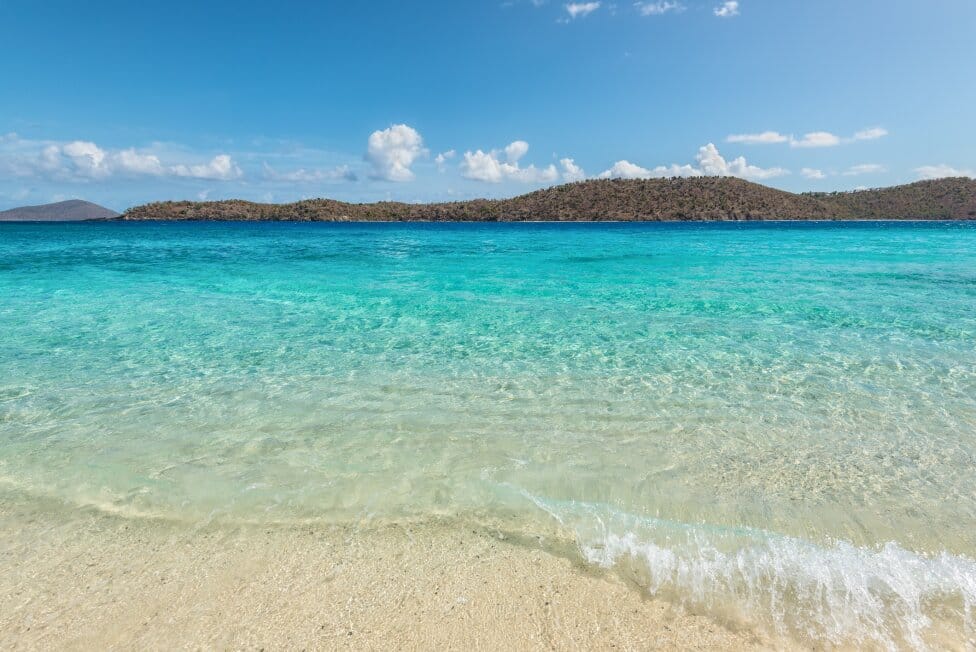
Coki Beach quickly became one of my favorite spots. The atmosphere was infectious, with local music playing and the smell of delicious food wafting from nearby stalls. The beach (like all the beaches) is powdery white sand and crystal-clear waters.
Highlights:
- Excellent Snorkeling: Right from the shore, I was greeted by schools of tropical fish.
- Lively Local Vibe: The beach is a popular spot for both tourists and locals.
- Convenient Amenities: Beach chair rentals, food stalls, and souvenir shops are readily available.
Sapphire Beach
Address: 6720 Smith Bay Rd, Smith Bay, St Thomas 00802, U.S. Virgin Islands
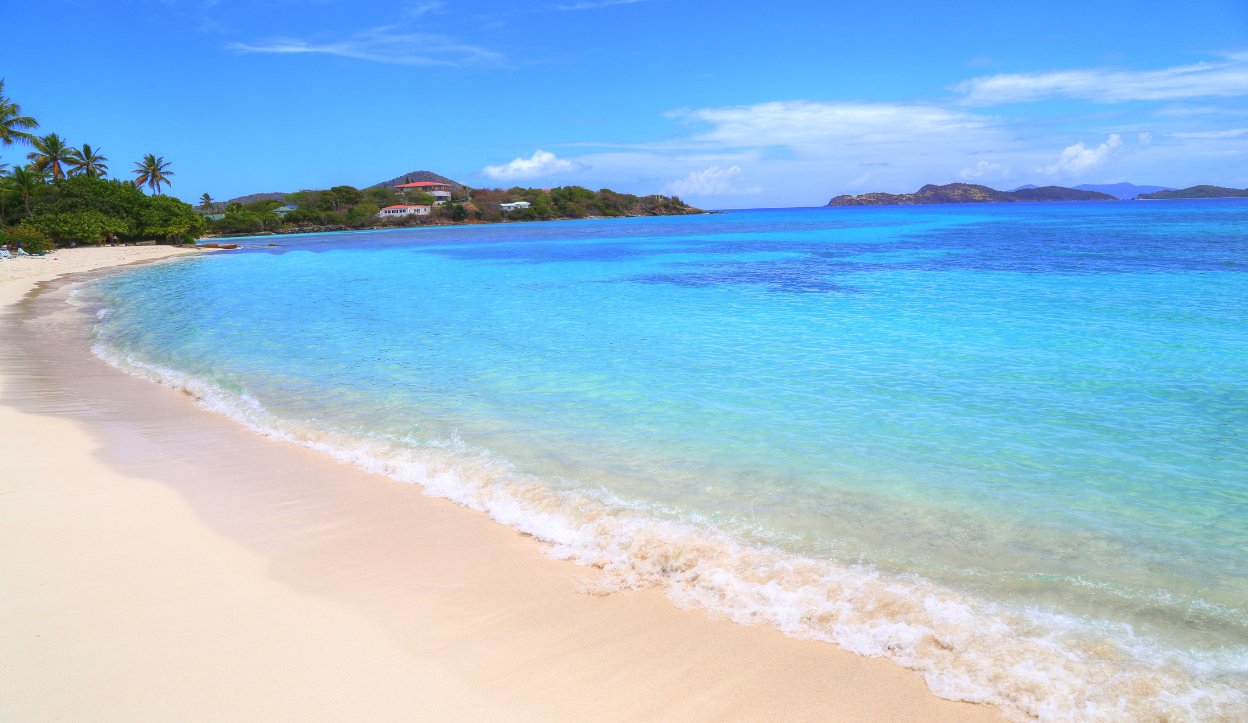
Sapphire Beach truly lives up to its name. The brilliant blue waters against the backdrop of soft white sand made it a picturesque spot for relaxation and perfect Kodak moments with my family.
Highlights:
- Water Sports Galore: I tried my hand at windsurfing and kayaking here.
- Snorkeling Opportunities: The shallow rocky ledge is perfect for spotting brain coral and tropical fish.
- Stunning Views: Panoramic sights of nearby St. John and the British Virgin Islands.
Secret Harbour Beach
Address: 6280 Estate Nazareth, Nazareth Bay, St Thomas 00802, U.S. Virgin Islands

Tucked away on the east end, Secret Harbour Beach felt like my own little paradise. The calm waters and serene environment were perfect for a laid-back day.
Highlights:
- Ideal for Swimming: The gentle waters make it safe and enjoyable.
- Marine Sanctuary: It's part of a designated marine sanctuary, so the snorkeling is phenomenal.
- Secluded Feel: Fewer crowds meant I could unwind without distractions.
Magen's Bay Beach
Address: 6200 Magens Bay Rd, St Thomas 00802, U.S. Virgin Islands
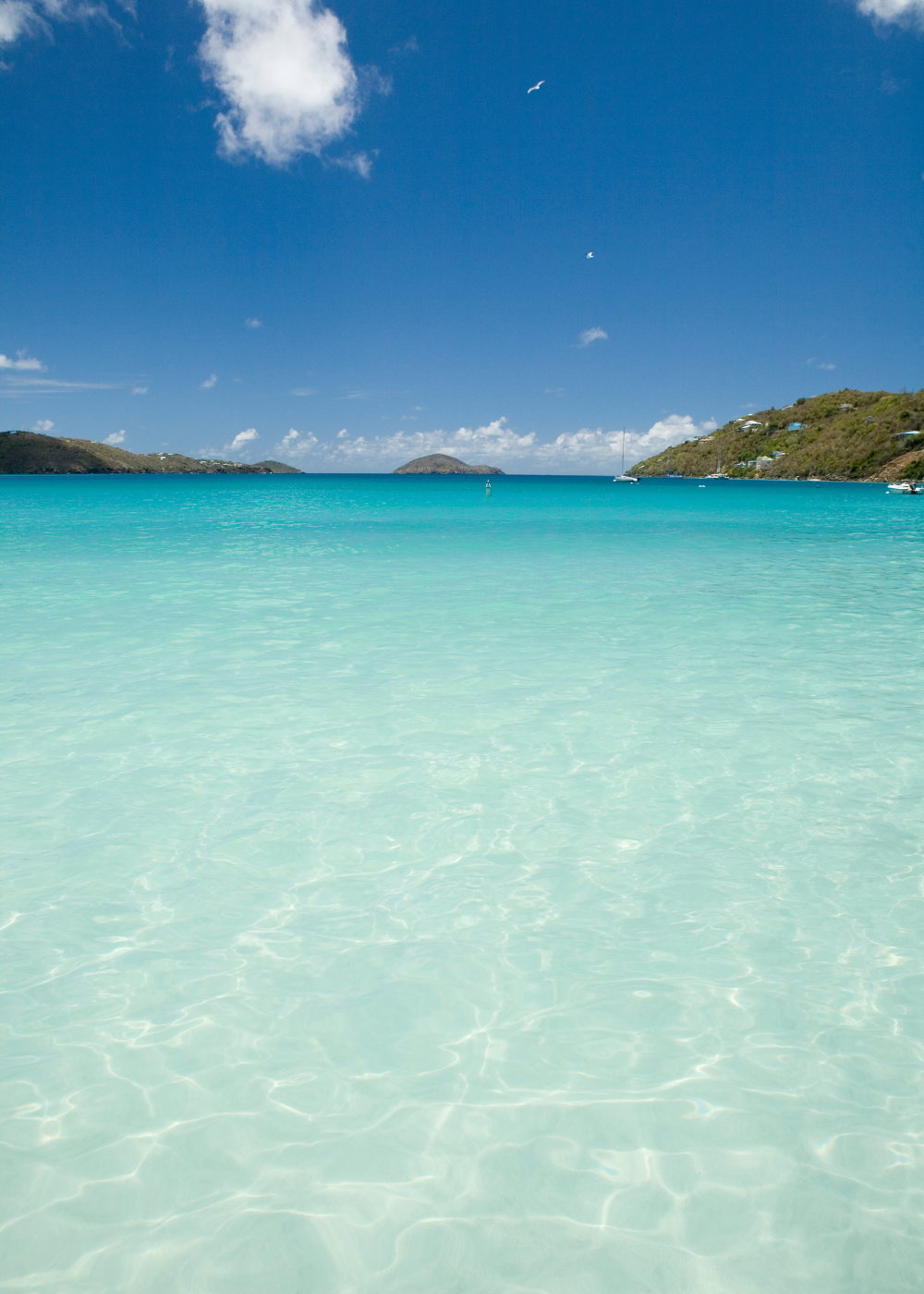
No trip to St. Thomas is complete without visiting Magens Bay Beach. Often listed among the world's most beautiful beaches, it certainly didn't disappoint.
Highlights:
- Stunning Horseshoe Shape: The unique layout provides calm, clear waters perfect for swimming.
- Family-Friendly Amenities: Lifeguards, picnic tables, and clean facilities are available.
- Scenic Drive: The journey to the beach offers panoramic views of the island.
Lindquist Beach
Address: Smith Bay Park, St Thomas 00802, U.S. Virgin Islands
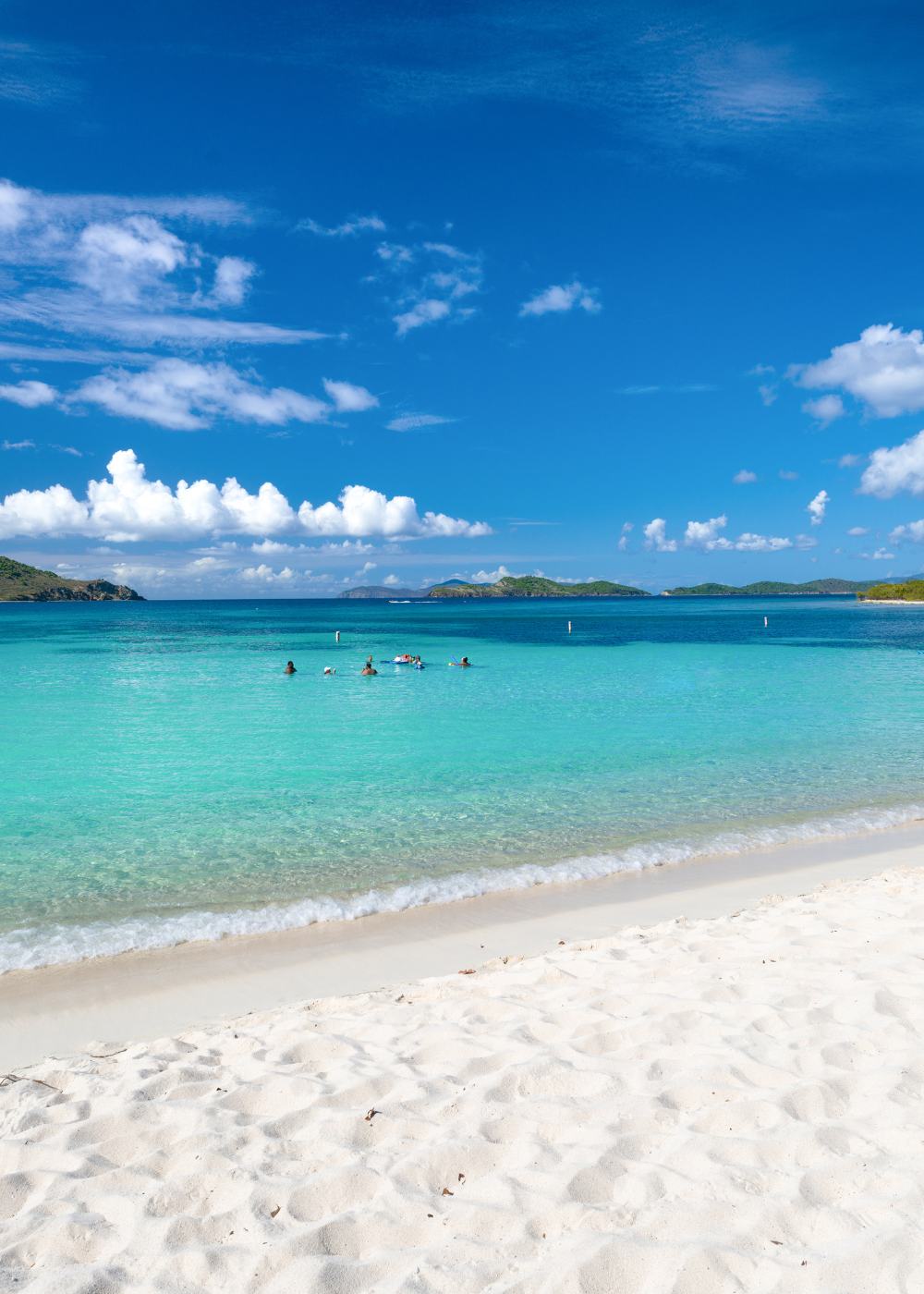
Lindquist Beach is a true hidden gem on St. Thomas, part of the protected Smith Bay Park. This beach has a more laid-back and peaceful vibe compared to some of the busier spots on the island. With its pristine white sand and crystal-clear waters, it’s a great choice if you’re looking to escape the crowds and enjoy a more tranquil beach day.
Highlights:
- Crystal-Clear Waters: The water is incredibly clear, making it ideal for swimming and floating along the gentle waves.
- Snorkeling Along the Shore: Explore the shallow reefs on either side of the beach, with plenty of fish and underwater life to discover.
- Stunning Views: The beach offers sweeping views of the British Virgin Islands in the distance, making for a picture-perfect backdrop.
- Peaceful and Uncrowded: Unlike some of the more tourist-heavy spots, Lindquist Beach is often quiet during the week, making it perfect for relaxing and enjoying the natural surroundings.
Lindquist Beach is the kind of place where you can spread out a towel, listen to the waves, and feel like you have a little slice of the Caribbean all to yourself, or at least that is the way it was when I visited.
Lesser-Known and Secluded Beaches
- Brewers Bay Beach: Located near the University of the Virgin Islands, it’s great for spotting sea turtles and offers a peaceful atmosphere with food trucks nearby.
- Hull Bay: A local favorite, especially among surfers when the north swell hits. Offers a laid-back vibe with a small beach bar and a rocky bottom that’s good for snorkeling.
- Vessup Bay: Known more to locals, this beach is a great spot for kiteboarding and windsurfing. It’s less developed and has a more natural, untouched feel.
- Limetree Beach (Formerly Bluebeard's Beach): You can use Lime Tree Beach in St. Thomas even if you aren't a guest at the associated Limetree Beach Resort, as it is a public beach.
Resort Beaches
All beaches in St. Thomas are public land, which grants public access to the shoreline up to 50 feet from the mean low tide mark regardless if there is a resort there.
- Morningstar Beach: A beautiful stretch of sand near the Marriott Frenchman’s Reef Resort. It’s great for guests staying at the resort or anyone looking for a quieter beach.
- Emerald Beach: Located near the airport, this beach is ideal for travelers looking for a quick dip. It has calm waters, a restaurant, and water sports rentals.
- Bolongo Bay: Connected to the Bolongo Bay Beach Resort, this beach is perfect for those looking to enjoy some cocktails by the water and take part in activities like paddleboarding and snorkeling.
- Honeymoon Beach (Water Island): Though technically on Water Island, just a short ferry ride from St. Thomas, Honeymoon Beach offers a relaxed vibe and clear waters. It’s a popular day trip for those seeking a quieter spot.
Small and Remote Beaches
- Neltjeberg Bay: A hidden gem that requires a bit of effort to reach, as the road can be challenging. Those who make it are rewarded with a beautiful, secluded beach.
- Mermaid’s Chair: A unique beach where the Caribbean Sea and the Atlantic Ocean meet. It’s accessible through a hike at the western end of St. Thomas, offering a more adventurous beach day.
- Santa Maria Bay: A small, quiet beach ideal for snorkeling and enjoying a peaceful day by the water.
Diving and Snorkeling In St. Thomas
St. Thomas is a haven for underwater enthusiasts like me. The vibrant coral reefs and diverse marine life make every dive and snorkel session an adventure.
Best Diving Locations:
Ledges of Little St. James
Location: Approximately 15 minutes by boat from the main island.

My dive at the Ledges of Little St. James was unforgettable. As a beginner-friendly site with depths ranging from 20-40 ft, it was perfect for divers of all levels.
Highlights:
- Rich Marine Life: I swam alongside turtles, stingrays, octopuses, and lobsters.
- Unique Underwater Terrain: The ledges and overhangs are teeming with colorful coral formations.
- Night Diving: The site offers a completely different experience after dark.
Buck Island Wall Dive

Buck Island Wall offers divers two main sites to explore: Dive Flag Rock and Andres' Reef. Located on the north side of Buck Island, this is one of the deeper dive options around St. Thomas, though it doesn’t feature the steep continental shelf drop-offs found near St. Croix. However, the wall here is home to some of the most beautiful reefs in the area.
This dive site has a bit of history too. Old machinery left behind from the 1960s now serves as artificial reef structures, creating a habitat for schools of blue and brown chromis, as well as the occasional eel or shark.
Depths range from 60-70 feet at the sandy bottom, while the top of the reef is at about 30 feet, making it an ideal multi-level dive. It’s common to spot stingrays and eagle rays gliding through the area, adding a touch of excitement to this already impressive underwater landscape.
For a full list of dive sites you can check out this guide.
Best Snorkeling Destinations:
Brewers Bay Beach
Address: Brewers Bay Road, St Thomas 00802, U.S. Virgin Islands

Brewers Bay Beach is a an amazing little gem located right next to the University of the Virgin Islands, and it's perfect for beginners.
Highlights:
- Swim with Sea Turtles: Grazing in the seagrass beds, green sea turtles and hawksbill turtles are common sights.
- Calm Waters: Ideal for snorkelers of all skill levels.
- Local Flavors: Food trucks nearby offer delicious local snacks like pates and johnny cakes.
Sapphire Beach
Revisiting Sapphire Beach for snorkeling was a fantastic idea. The right side of the beach features a shallow rocky ledge that's a hotspots for marine life, and the beach is a also a great areas to do a little hiking.

Highlights:
- Protected Reef: The well-preserved coral reefs are patrolled by the "Snorkel Police" to prevent damage.
- Diverse Sea Creatures: From colorful tropical fish to the occasional turtle or ray.
- Convenient Facilities: Gear rentals and beach amenities make for a hassle-free experience.
Island Hopping
Ferry Routes, Destinations, Costs, and Schedules From St. Thomas
St. Thomas serves as a central hub for ferry transportation in the U.S. Virgin Islands and to destinations in the British Virgin Islands. St. Thomas is only 3 mile from St. Johns and there are ferries departing hourly.
If you're staying on St. Thomas and looking to explore neighboring islands, this guide provides a complete list of ferry destinations available from St. Thomas, including details on routes, schedules, costs, and travel times.
Ferry Destinations from St. Thomas
- St. John (U.S. Virgin Islands)
- Destination on St. John: Cruz Bay
- Departure Points on St. Thomas: Red Hook, Charlotte Amalie
- Travel Time:
- From Red Hook: Approximately 15-20 minutes
- From Charlotte Amalie: Approximately 35-45 minutes
- Ferry Frequency:
- Red Hook to Cruz Bay: Ferries depart hourly from early morning (~6:00 AM) to midnight.
- Charlotte Amalie to Cruz Bay: Fewer daily departures, typically 3-5 times per day.
- Cost:
- Red Hook:
- 1-WAY FARE PRICES: Adult: $6.00 | Adult Non-Resident: $8.15 | V.I. Senior Citizen: $1.50* | Child: $1.00 | Infant: Free | Bag Fee $4.00
- Charlotte Amalie:
- 1-WAY FARE PRICES: Adult: $12.00 | Adult Non-Resident: $13 | V.I. Senior Citizen: $6.00* | Child: $3.50 | Infant: Free | Bag Fee $4.00
- Red Hook:
Notes: This is the most frequent and convenient ferry route, ideal for day trips to explore St. John's beaches and hiking trails.
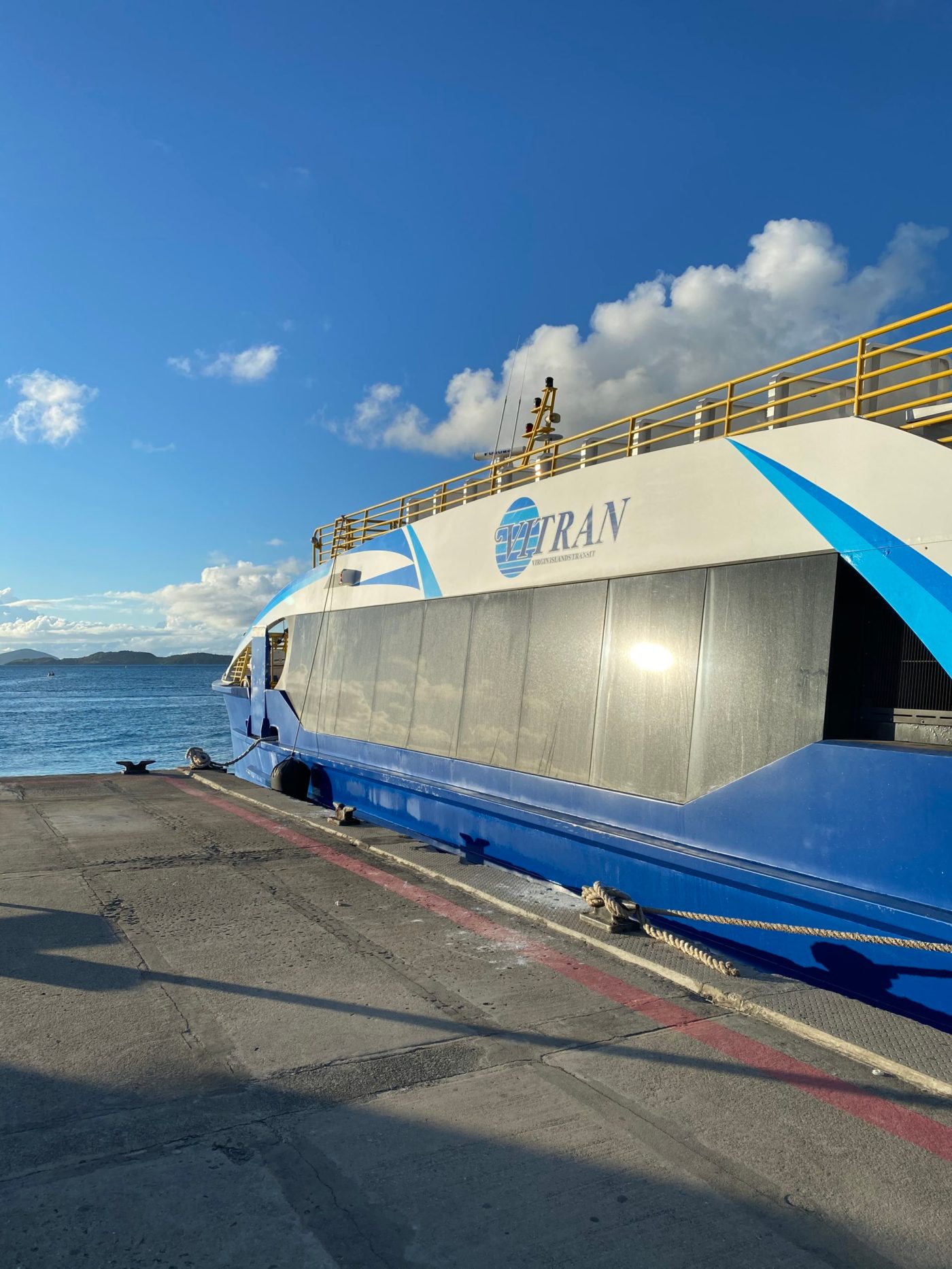
- Water Island (U.S. Virgin Islands)
- Destination on Water Island: Phillips Landing (near Honeymoon Beach)
- Departure Point on St. Thomas: Crown Bay Marina
- Travel Time: Approximately 10 minutes
- Ferry Frequency: Ferries run daily, departing every hour or half-hour from early morning (~6:30 AM) to evening (~6:00 PM).
- Cost: Around $10 round-trip for adults, discounts available for children.
- Notes: Water Island is just 1 mile south of St. Thomas, offering a quiet retreat with beautiful beaches.
- St. Croix (U.S. Virgin Islands)
- Destination on St. Croix: Gallows Bay, Christiansted
- Departure Point on St. Thomas: Blyden Ferry Terminal in Charlotte Amalie
- Travel Time: Approximately 2 hours
- Ferry Frequency: Limited service, typically 3-4 times per week.
- Cost: Around $50 one-way for adults, $90 round-trip.
- Notes: The ferry between St. Thomas and St. Croix is less frequent. Flying is a more common option, but the ferry provides a scenic alternative.
- Tortola (British Virgin Islands)
- Destinations on Tortola: Road Town, West End
- Departure Points on St. Thomas: Charlotte Amalie, Red Hook
- Travel Time: Approximately 45-60 minutes
- Ferry Frequency: Ferries run daily, with multiple departures ranging from 3-5 times per day.
- Cost:
- From Charlotte Amalie to Road Town: Around $60 round-trip for adults.
- From Red Hook to West End: Similar pricing.
- Additional departure taxes and customs fees apply (approximately $20-30 total).
- Notes: A valid passport is required for entry into the British Virgin Islands (BVI).
- Virgin Gorda (British Virgin Islands)
- Destination on Virgin Gorda: Spanish Town
- Departure Points on St. Thomas: Charlotte Amalie, Red Hook
- Travel Time: Approximately 1.5 to 2 hours
- Ferry Frequency: Limited service, often 2-3 times per week; schedules are seasonal.
- Cost: Around $70-90 round-trip for adults, plus departure taxes and customs fees.
- Notes: Check schedules in advance due to limited availability. Virgin Gorda is famous for The Baths, a must-see attraction.
- Jost Van Dyke (British Virgin Islands)
- Destination on Jost Van Dyke: Great Harbour
- Departure Point on St. Thomas: Red Hook
- Travel Time: Approximately 45 minutes to 1 hour
- Ferry Frequency: Limited service, usually 1-2 times per day; may vary seasonally.
- Cost: Around $70-80 round-trip for adults, plus departure taxes and customs fees.
- Notes: Known for its iconic beach bars like Soggy Dollar Bar and Foxy's.
- Anegada (British Virgin Islands)
- Destination on Anegada: Setting Point
- Departure Point on St. Thomas: Charlotte Amalie (limited service)
- Travel Time: Approximately 2.5 to 3 hours
- Ferry Frequency: Very limited, often once per week or via special charters.
- Cost: Approximately $100-120 round-trip for adults, plus additional fees.
- Notes: Due to limited ferry service, consider arranging a charter or flying. Anegada is known for its flat landscape and beautiful beaches.
- Peter Island, Cooper Island, Norman Island (British Virgin Islands)
- Departure Point on St. Thomas: Typically via private charter or water taxi from Red Hook or Charlotte Amalie.
- Travel Time: Varies by island, generally 1-2 hours
- Ferry Frequency: No regular ferry service; travel is typically arranged through private operators.
- Cost: Costs vary widely based on the operator and number of passengers.
- Notes: Ideal for groups; a passport is required for BVI entry.
- St. Thomas Harbor Island Tours
- Destinations: Various small islands and cays around St. Thomas, such as Christmas Cove, Lovango Cay, and Hans Lollik Island.
- Departure Point: Typically from Red Hook or Charlotte Amalie.
- Travel Time: Short trips ranging from 15-30 minutes.
- Ferry Frequency: Offered by private tour companies on a scheduled or charter basis.
- Cost: Varies based on tour package.
- Notes: Great for snorkeling excursions and day trips.
General Tips for Ferry Travel from St. Thomas
- Check Updated Schedules: Ferry schedules can change due to weather conditions, seasonal demand, or operational considerations. Always verify the latest schedules with the ferry operators before planning your trip.
- Passport Requirements: Traveling to the British Virgin Islands requires a valid passport. Ensure your travel documents are in order before departure.
- Arrival Time: Arrive at the ferry terminal at least 45 minutes before departure for domestic trips, and 1 hour before for international trips to allow time for ticketing and customs procedures.
- Departure Taxes and Fees: Be prepared to pay additional departure taxes and customs fees when traveling to and from the British Virgin Islands. These are typically paid in cash.
- Baggage Allowances: Some ferry operators may charge extra for baggage, especially large or additional bags. Check baggage policies in advance.
- Sea Conditions: The Caribbean Sea can be rough at times. If you're prone to seasickness, consider taking preventive measures.
- Payment Methods: While some ferry operators accept credit cards, it's advisable to carry enough cash (USD) to cover tickets and fees.
Ferry Operators from St. Thomas
- Inter-Island Boat Services
- Native Son Ferry
- Smith's Ferry Services
- Road Town Fast Ferry
- Dolphin Water Taxi (Private charters)
- Crown Bay Ferry (to Water Island)
- QE IV Ferry (between St. Thomas and St. Croix; limited service)
Ferry Schedule Overview
- St. Thomas to St. John (Red Hook to Cruz Bay):
- Departures from Red Hook: Hourly from 6:00 AM to 11:00 PM
- Departures from Cruz Bay: Hourly from 6:00 AM to 10:00 PM
- St. Thomas to Tortola:
- Departures from Charlotte Amalie:
- Morning: 7:15 AM, 8:00 AM
- Midday: 12:00 PM
- Afternoon: 4:00 PM
- Departures from Red Hook:
- Morning: 8:00 AM
- Afternoon: 2:30 PM, 5:00 PM
- Departures from Charlotte Amalie:
- St. Thomas to St. Croix (Limited Service):
- Departures: Typically on Monday, Wednesday, and Friday at 8:00 AM
- Return from St. Croix: Same days at 4:00 PM
Note: These schedules are examples and may have changed. Always consult the ferry operators for the most current information.
Distances Between Islands from St. Thomas
- St. John: Approximately 4 miles east
- Water Island: Approximately 1 mile south
- St. Croix: Approximately 40 miles south
- Tortola: Approximately 12 miles northeast
- Virgin Gorda: Approximately 30 miles northeast
- Jost Van Dyke: Approximately 24 miles northwest
- Anegada: Approximately 60 miles northeast
Exploring the surrounding islands when visiting St. Thomas is a great way to enhance your Caribbean experience, as you can take in the attractions on many islands instead of just one.
Other Attractions Besides Beaches, and Diving
Exploring Charlotte Amalie
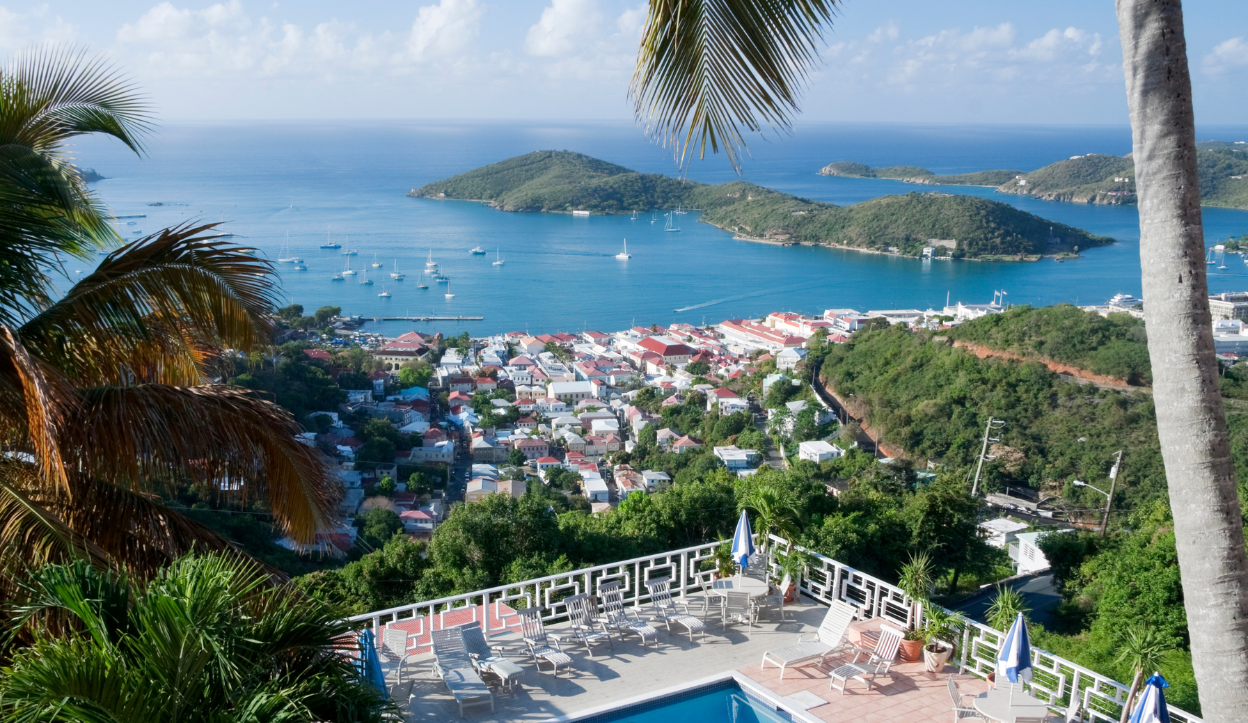
Walking through Charlotte Amalie, the capital city, was like stepping back in time.
Highlights:
- Historic Architecture: The Danish colonial buildings are stunning.
- Duty-Free Shopping: A great place to pick up souvenirs.
- Skyride to Paradise Point: Offers panoramic views of the island.
Coral World Ocean Park
Address: 6450 Coki Point, St Thomas 00802, U.S. Virgin Islands

Visiting Coral World was both educational and entertaining.
Highlights:
- Underwater Observatory: A unique way to view marine life without getting wet.
- Interactive Exhibits: I even got to touch a shark!
- Sea Lion Encounters: An unforgettable experience with these playful creatures.
Mountain Top
Address: 00801 St Thomas, U.S. Virgin Islands

At 1,500 feet above sea level, Mountain Top offers the best views on the island.
Highlights:
- Panoramic Vistas: Overlooking Magens Bay and neighboring islands.
- World-Famous Daiquiris: Refreshing drinks to enjoy with the view.
- Local Crafts: Shops offering handmade souvenirs.
Things to Know Before You Go
Let's cover some final basic things you should know before you go to St. Thomas, as well as budget needed and the areas you can pick to stay in.
- Currency: U.S. dollar (USD), so no need to exchange currency
- Driving: Remember, they drive on the left!
- Passport: Being a US Territory, US citizens don't need to show a passport to enter or exit the islands. It's the same as just flying to another state.
- Safety: The island is very safe, no need to do anything other than have basic common sense.
St. Thomas Travel Cost: Vacation Expense Estimate
St. Thomas is actually not as expensive as one might think when comparing it with other beach destinations in the US. Lodging is comparable to most beach destinations in the US, however food and drink will be a bit cheaper than what you might expect to spend in a place like Miami or Gulf Shores. Here's a breakdown of what you can expect to spend.
Accommodation Costs
- Budget Hotels: $100 - $150 per night
- Expect basic amenities with clean rooms, perfect for travelers focusing more on exploring than lounging.
- Some budget options may include complimentary breakfast.
- Moderate Hotels: $175 - $300 per night
- A step up in comfort and amenities, these often include pools, restaurants, and proximity to beaches.
- Many family-friendly resorts fall into this range.
- Luxury Resorts: $400 - $900+ per night
- High-end resorts like The Ritz-Carlton or Marriott's Frenchman’s Cove offer oceanfront views, premium dining options, and world-class service.
- Ideal for honeymooners or those looking for a splurge-worthy stay.
Food Costs
- Budget Dining: $10 - $15 per meal
- Try local food trucks, casual cafes, or grab a quick bite from roadside stands offering Caribbean favorites like patties, jerk chicken, and roti.
- Moderate Dining: $20 - $40 per meal
- Sit-down restaurants and beach bars often fall into this range, serving dishes like fresh seafood, Caribbean fusion cuisine, and BBQ.
- Fine Dining: $60+ per meal
- Upscale restaurants offer exquisite dining experiences with breathtaking ocean views. Enjoy lobster, steaks, and chef’s tasting menus for a memorable evening.
Transportation Costs
- Taxi:
- Fares vary depending on distance, but a typical short ride (1-2 miles) costs around $6-$10 per person.
- Longer distances, like from the airport to major resorts, range from $15-$30 per person.
- Taxis are usually shared with others traveling to nearby locations, but you can pay extra for a private ride.
- Rental Cars:
- $60 - $90 per day for a standard car.
- Uber/Lyft: Not available on the island.
- Taxis are the primary mode of transportation for visitors.
Snorkel Gear Rental Costs
- Snorkel Gear: Around $10 - $20 per day for a mask, snorkel, and fins.
- Some beachside stands and dive shops offer weekly rental rates, usually at a discount (about $40 - $60 per week).
Alcohol and Beer Costs
- Local Beer: $3 - $5 per bottle at bars and beach bars.
- You can find Carib and St. John Brewers beer at most local bars.
- In grocery stores, expect prices around $1.50 - $2.50 per bottle.
- Cocktails: $8 - $15 depending on the location and type of drink.
- Island favorites like rum punch or painkillers are a must-try.
- Wine: $8 - $12 per glass at moderate establishments, with higher-end spots charging up to $15-$20.
- Bottle of Rum (in grocery or duty-free shops): $10 - $20 for local brands like Cruzan or Captain Morgan.
Daily Budget Overview
Here’s a rough estimate of what you might spend per day, depending on your travel style:
- Budget Traveler: $125 - $200 per day
- Includes basic lodging, affordable meals, shared taxi rides, and occasional attractions.
- Moderate Traveler: $250 - $400 per day
- Comfortable lodging, a mix of local and sit-down dining, rental car or taxis, and a few paid activities.
- Luxury Traveler: $500+ per day
- High-end accommodations, fine dining, private transport, and exclusive experiences like resort day passes.
St. Thomas Areas To Stay In
Choosing the right area to stay depends on your travel style and preferences—whether you’re looking for luxury resorts, family-friendly beaches, or local vibes.
Here are the most common areas visitors choose to to stay in when visiting St. Thomas:
Charlotte Amalie
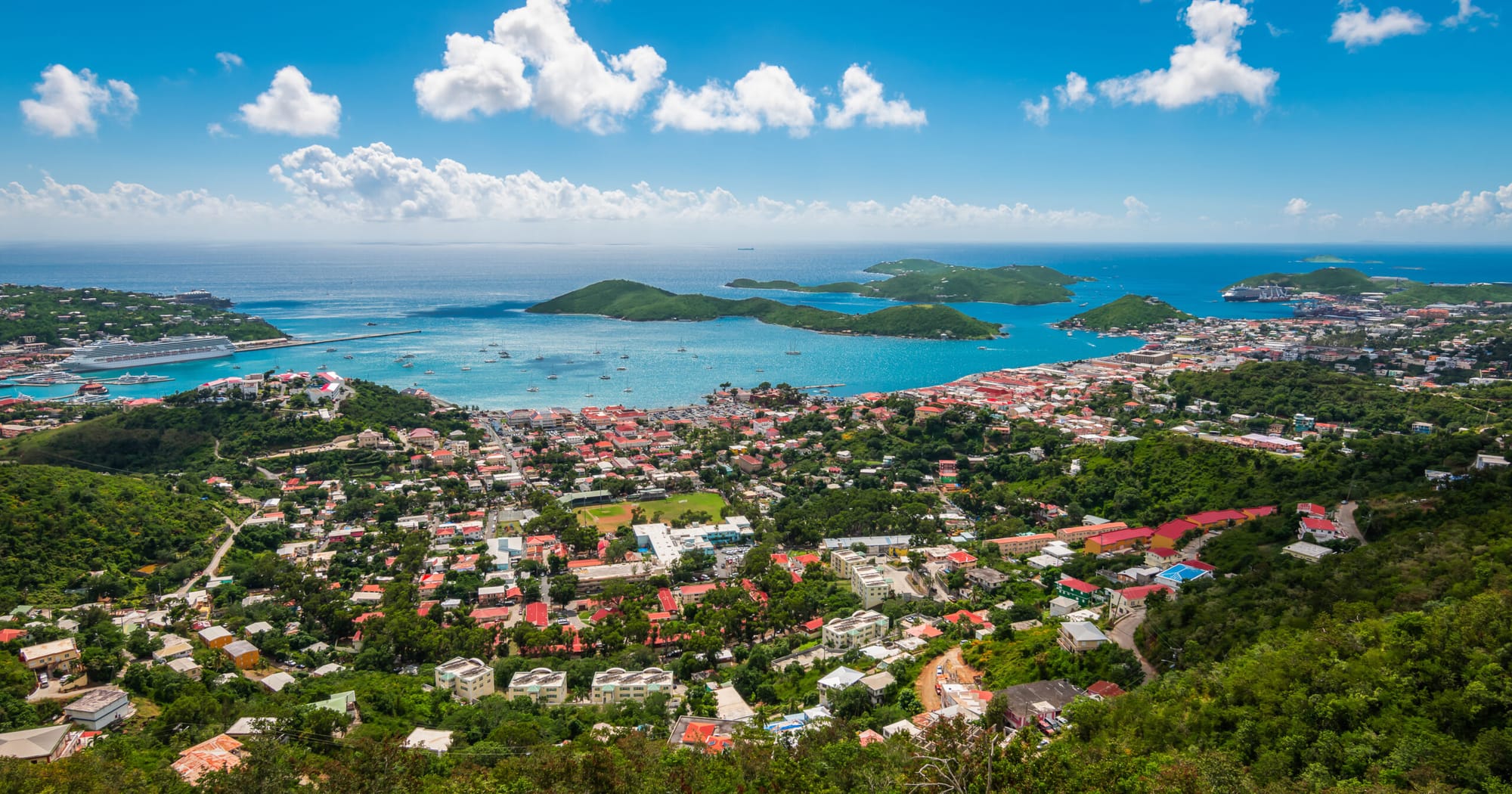
- Best for: History buffs, shopping enthusiasts, nightlife seekers
- Why Stay Here: This is the capital city and the main port of St. Thomas, making it a hub for shopping, dining, and entertainment. You’ll find duty-free shops, local markets, and historic sites like Fort Christian.
- Accommodations: Expect a mix of boutique hotels and larger resorts. It’s a great spot if you want to be close to the action and nightlife.
Red Hook
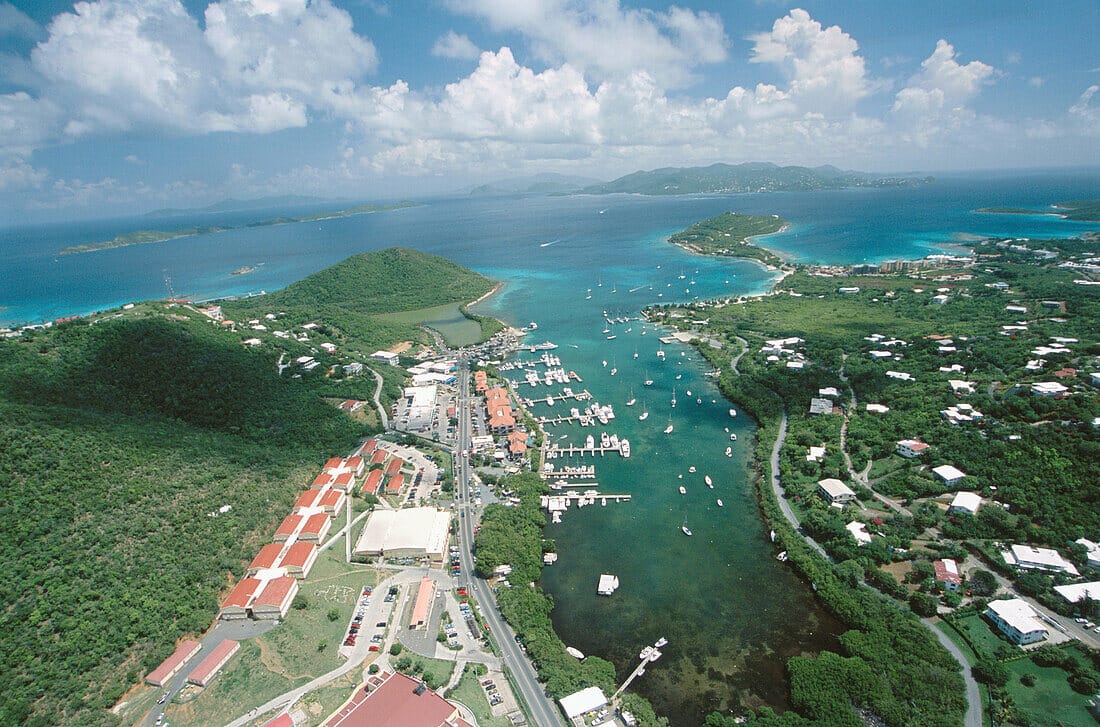
- Best for: Ferry access, dining, nightlife
- Why Stay Here: Located on the east end of the island, Red Hook is known for its bars, restaurants, and easy access to ferries to St. John and the British Virgin Islands. It’s perfect for those who want to island hop or enjoy a lively nightlife scene.
- Accommodations: You’ll find vacation rentals and mid-range hotels here, making it ideal for those looking for a more local feel while staying close to conveniences.
Magens Bay
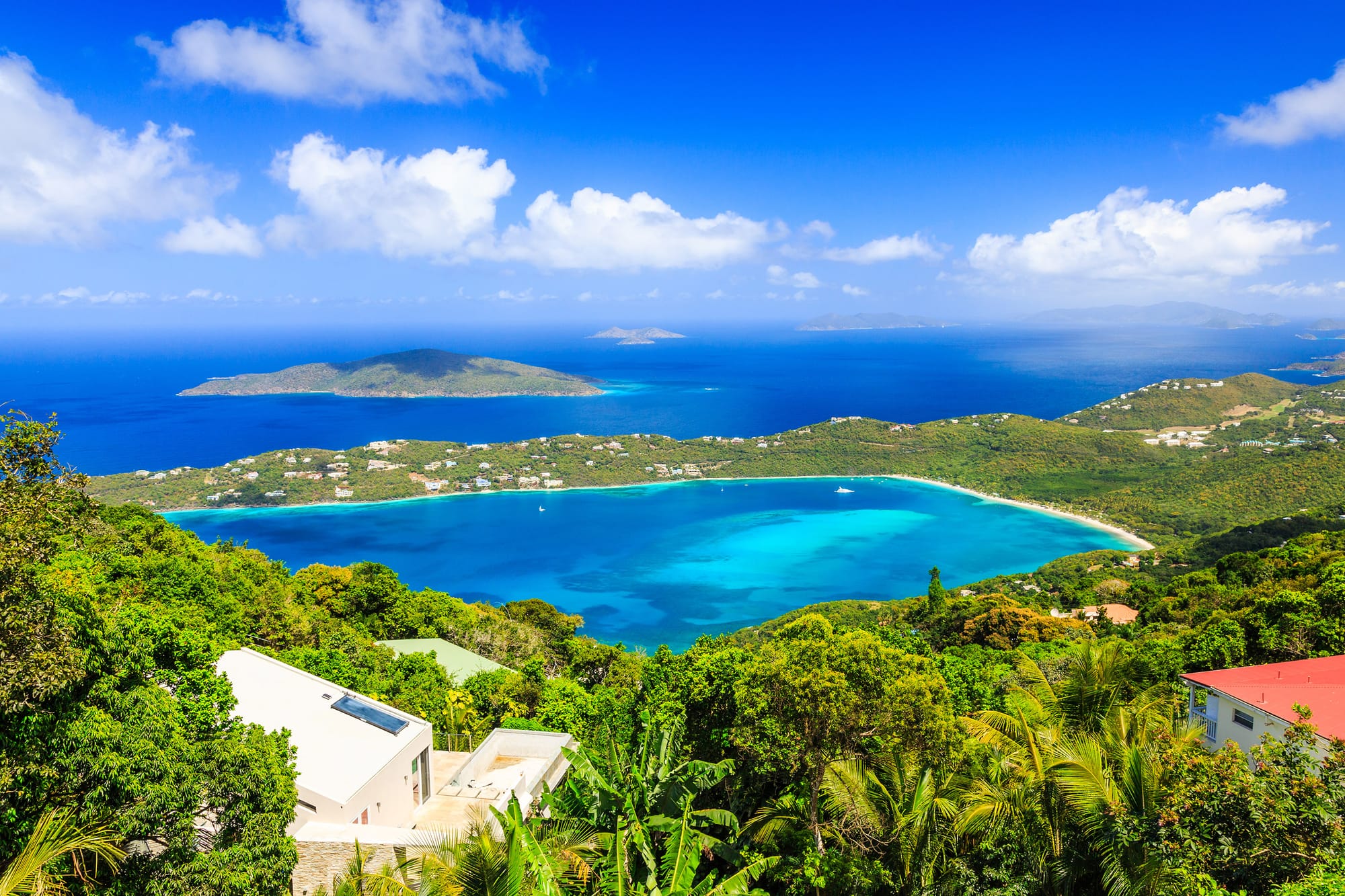
- Best for: Beach lovers, families, nature enthusiasts
- Why Stay Here: Magens Bay is often considered one of the most beautiful beaches in the Caribbean. This area is great for families and couples who want a relaxing beach vacation with easy access to water sports and nature trails.
- Accommodations: Mostly luxury villas and upscale resorts with stunning views of the bay. It’s more tranquil than the busier areas like Charlotte Amalie.
Havensight
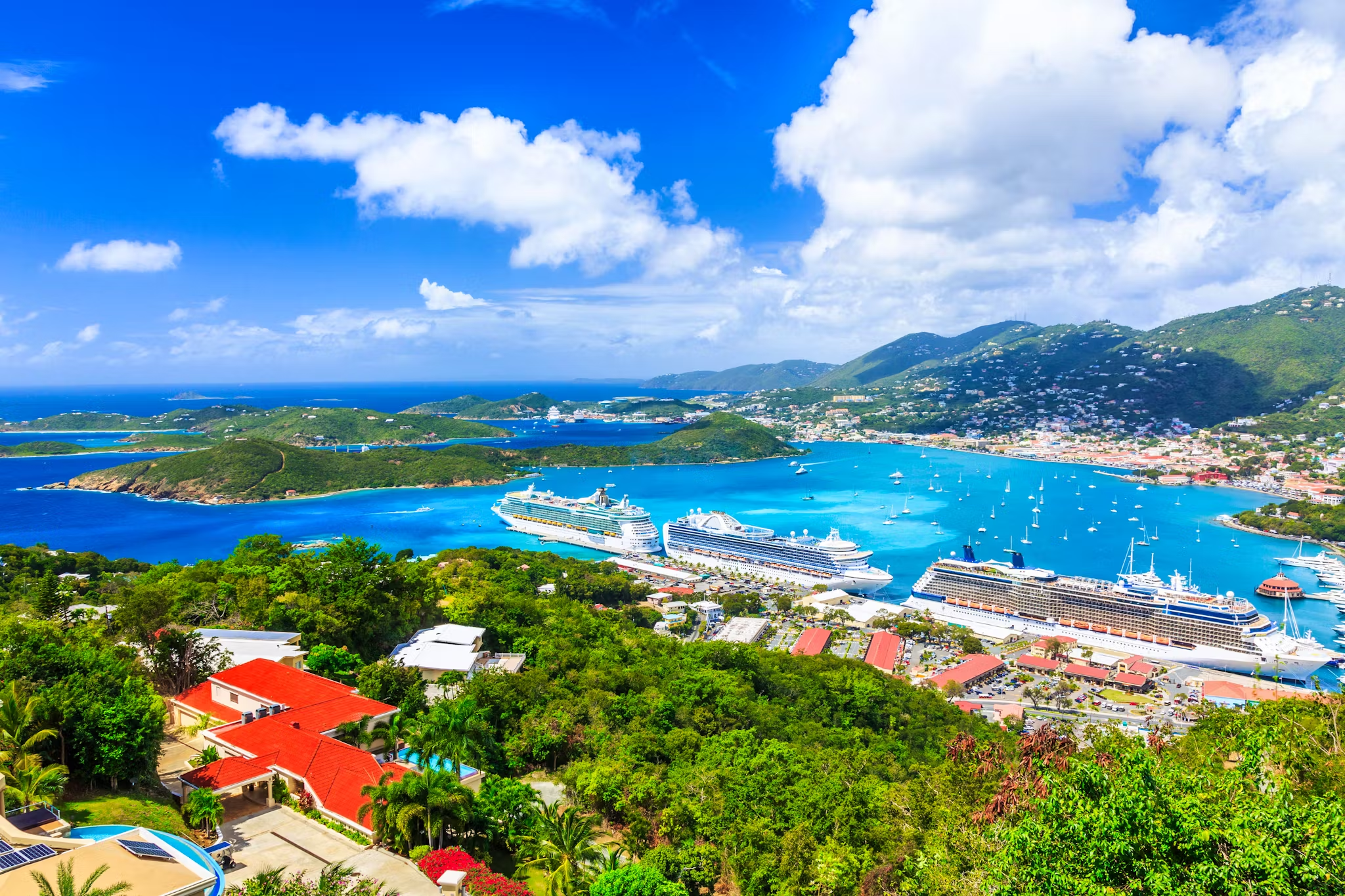
- Best for: Cruise visitors, short stays, shopping
- Why Stay Here: Close to the cruise port, Havensight is ideal if you’re visiting for a short stay or arriving by cruise ship. It’s home to Havensight Mall, where you’ll find duty-free shopping and a variety of restaurants.
- Accommodations: Mainly mid-range hotels and vacation rentals, offering a convenient spot for those wanting to be near the port and downtown Charlotte Amalie.
Northside
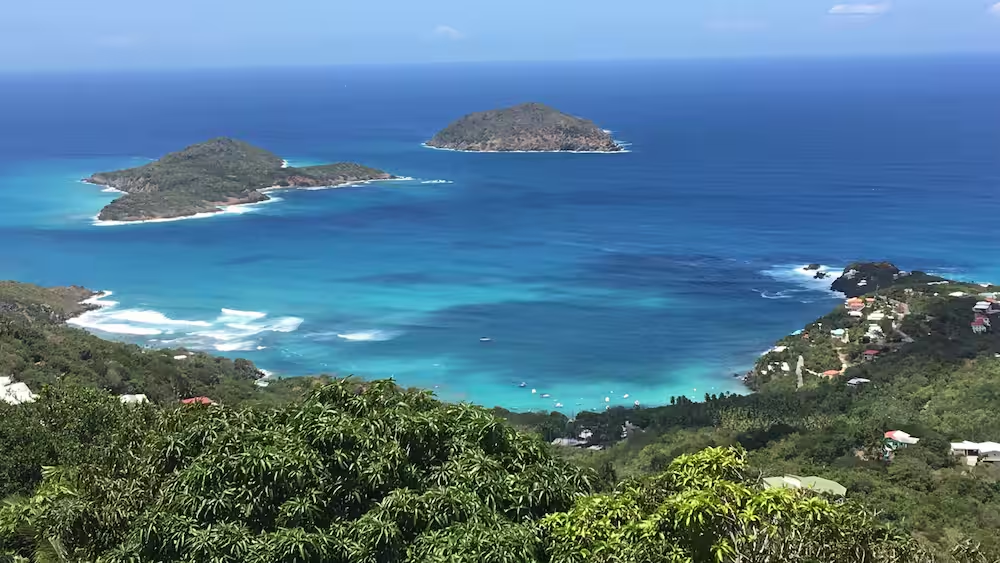
- Best for: Seclusion, nature, local experiences
- Why Stay Here: The Northside offers a more remote and serene experience. It’s perfect for those looking to escape the crowds and enjoy local vibes and breathtaking views. Hull Bay is a popular spot for surfing and snorkeling.
- Accommodations: Primarily vacation rentals and small inns. This is a great spot if you prefer to be surrounded by nature and local communities.
East End
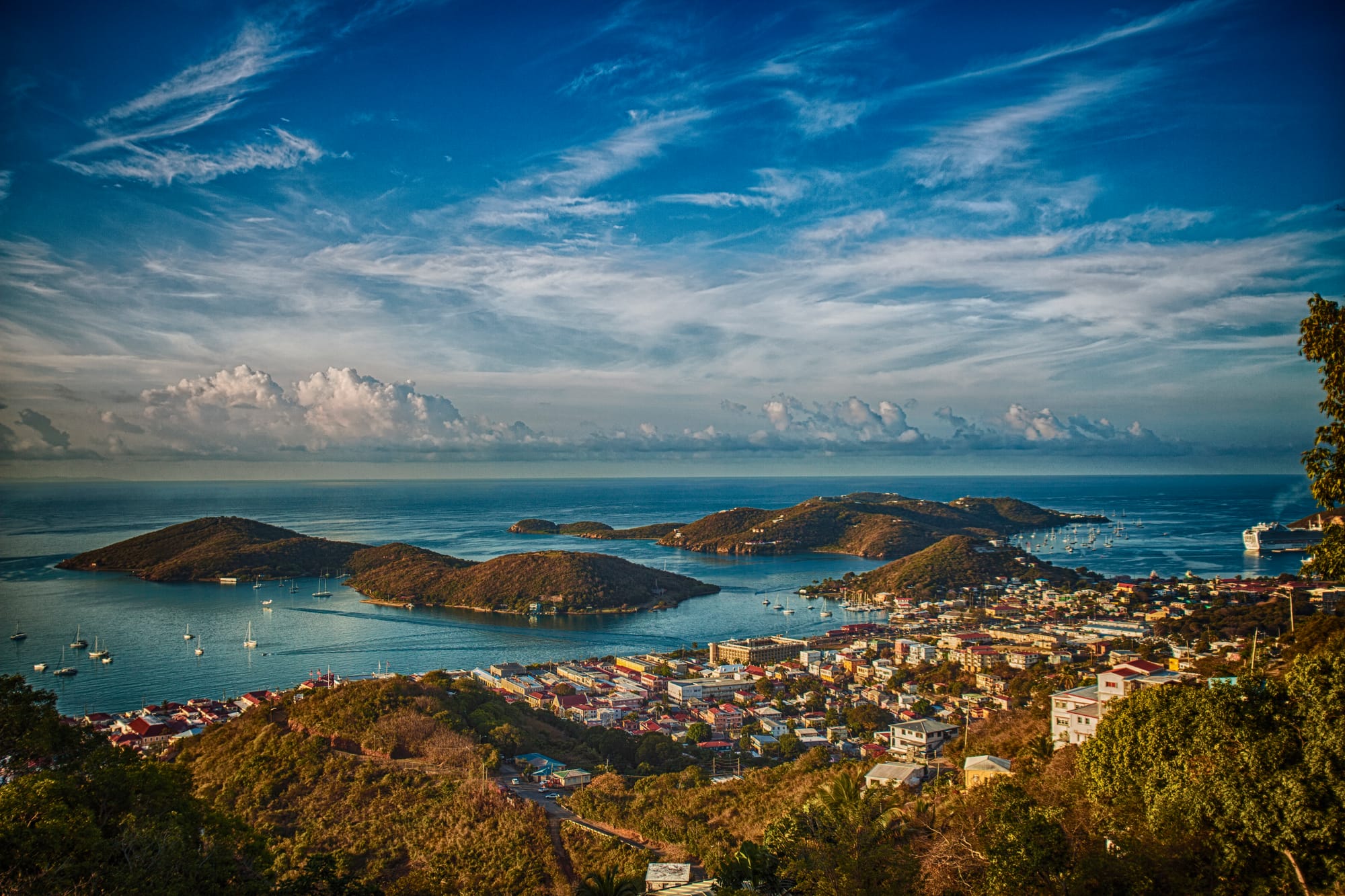
- Best for: Luxury stays, beach access, quiet retreats
- Why Stay Here: The East End of St. Thomas is known for its secluded beaches and upscale resorts. It’s ideal for travelers seeking luxury and privacy while still being within reach of Red Hook’s dining and ferry options.
- Accommodations: Expect high-end resorts, luxury villas, and beachfront rentals. This area is known for properties like the Ritz-Carlton and Secret Harbour Beach Resort.
Coki Point and Coral World
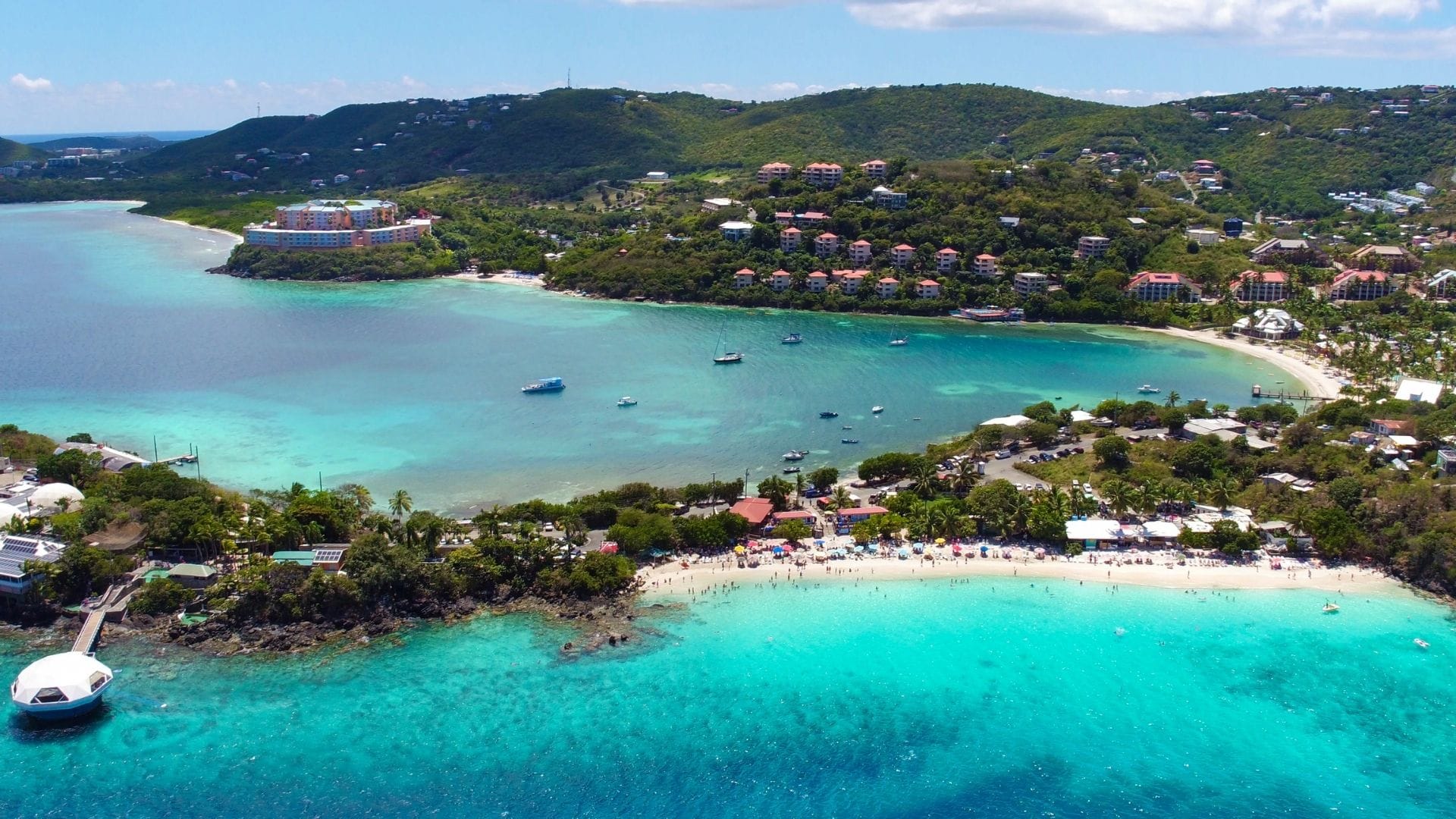
- Best for: Families, snorkeling enthusiasts, marine life
- Why Stay Here: Home to Coki Beach and Coral World Ocean Park, this area is a hit with families and those who love marine life. It’s one of the best spots on the island for snorkeling, with easy access to vibrant coral reefs.
- Accommodations: A mix of affordable hotels and vacation rentals makes this a great spot for those traveling on a budget or with kids.
West End and Frenchman's Bay

- Best for: Relaxation, romantic getaways, nature
- Why Stay Here: This area offers picturesque views and secluded beaches, making it perfect for honeymoons and romantic retreats. It’s quieter than other parts of the island but still offers stunning sunsets and beautiful coastal views.
- Accommodations: Expect boutique hotels, luxury resorts, and romantic villas. It’s a great option if you want to be close to Charlotte Amalie but in a more peaceful setting.
Each area of St. Thomas offers a unique experience, whether you're looking for the lively atmosphere of Red Hook, the pristine beaches of Magens Bay, or the local charm of the Northside. Wherever you stay, you'll be treated to stunning views and easy access to the island’s natural beauty and rich culture.
That wraps up our St. Thomas travel guide. We hope it inspires and helps you plan an unforgettable trip to St. Thomas, USVI.
Other Popular Post
